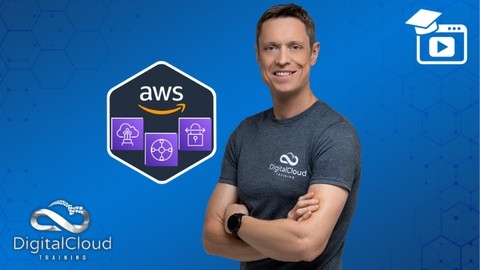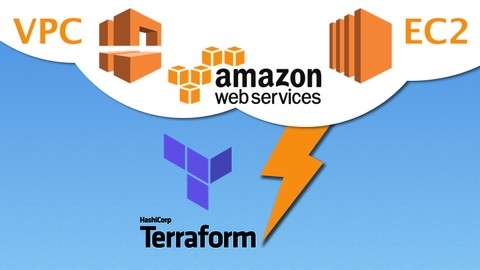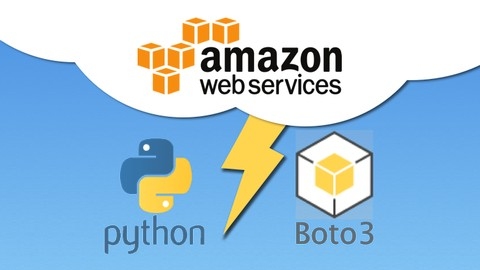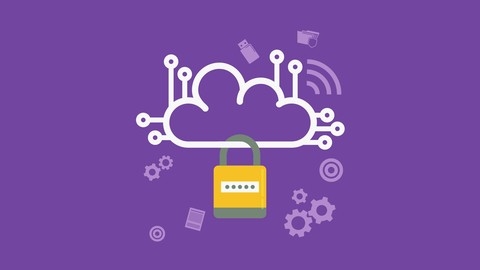AWS Virtual Private Cloud (VPC) is a fundamental service within Amazon Web Services (AWS) that allows you to create a secure, isolated network environment within the AWS cloud.
By learning VPC, you gain the ability to design, deploy, and manage your applications and services in a secure and scalable manner.
You can configure network connectivity, security rules, and routing to ensure optimal performance and compliance with your organization’s security policies.
Finding a high-quality AWS VPC course on Udemy can be a daunting task.
With so many options available, it’s easy to feel overwhelmed and unsure where to start.
You’re looking for a course that goes beyond theory and provides practical experience, hands-on projects, and real-world examples to solidify your understanding.
We’ve reviewed countless courses and based on our analysis, AWS VPC and Networking in depth: Learn practically in 8 hrs is the best course overall.
This comprehensive Udemy course combines deep dives into core VPC concepts with practical exercises that allow you to build real-world solutions.
From creating basic VPCs and subnets to implementing advanced connectivity options like VPC peering and Transit Gateway, this course covers everything you need to confidently work with AWS VPC in real-world scenarios.
While this is our top pick, other excellent options are available on Udemy.
Keep reading to discover our full list of recommendations tailored to different learning styles, experience levels, and specific AWS networking skills you’d like to master.
AWS VPC and Networking in depth: Learn practically in 8 hrs
You’ll start with the fundamentals, learning about VPCs, subnets, routing tables, and networking components like security groups and network ACLs.
Through hands-on exercises, you’ll gain practical experience creating VPCs with public and private subnets, configuring NAT gateways and instances.
The course dives deep into advanced VPC connectivity options like VPC peering across regions, VPC endpoints for private access to AWS services like S3 and SQS, and VPC PrivateLink for exposing application services privately.
You’ll also learn about hybrid networking solutions like Site-to-Site VPN and Client VPN, with exercises covering different scenarios like accessing the internet via VPC internet gateway or split tunneling.
Another highlight is the extensive coverage of AWS Transit Gateway, a service for centralizing routing and connectivity between VPCs and on-premises networks.
Hands-on labs will teach you to set up full connectivity between multiple VPCs or restrict access with attachment-specific routes.
For hosting web applications, you’ll learn to use Route53 for DNS management, including region-level failover and assigning custom domain names.
The course covers hosting websites on S3 with CloudFront for content delivery and HTTPS support.
You’ll also master the Application Load Balancer (ALB) service, configuring routing rules, session stickiness, host-based routing, and HTTPS termination.
Finally, you’ll learn to deploy VPC infrastructure using CloudFormation, an infrastructure-as-code service.
The course culminates with a comprehensive assignment to deploy a highly available, multi-AZ web application with HTTPS support.
With its extensive syllabus, hands-on approach, and coverage of essential AWS networking services like VPC, Transit Gateway, VPN, Route53, ALB, and CloudFormation, this course equips you with the skills to confidently work with AWS VPC and networking in real-world scenarios.
AWS Networking Masterclass - Amazon VPC & Hybrid Cloud 2024
You’ll start by learning networking fundamentals like IP addressing, routing, and firewalls - essential knowledge for working with VPCs.
Then, the course dives deep into Amazon VPC, covering everything from VPC architecture and subnets to security groups, NACLs, and NAT gateways.
With hands-on labs, you’ll gain practical experience creating custom VPCs, configuring routing, and launching instances into subnets.
It covers advanced VPC connectivity options like VPC peering, VPC endpoints, and hybrid connectivity using AWS Site-to-Site VPN, Client VPN, and Direct Connect.
You’ll even learn how to set up a VPN CloudHub and Transit Gateway for complex networking scenarios.
Load balancing is another key topic, with labs on Elastic Load Balancing (Application and Network Load Balancers), as well as Global Accelerator for improving global application performance.
You’ll also dive into monitoring and logging with CloudWatch, CloudTrail, VPC Flow Logs, and Traffic Mirroring.
The course equips you with automation skills too, teaching you to use the AWS CLI and CloudFormation to provision VPC resources programmatically.
And with lessons on EC2 networking, ENIs, ENA, and EFA, you’ll understand how instances connect to your VPC.
Throughout the course, you’ll work with services like Route 53 for DNS, NAT instances for NAT capabilities, and Reachability Analyzer for troubleshooting connectivity issues.
The hands-on labs ensure you gain real-world experience with these services.
VPC Solutions with EC2 for Production: AWS with Terraform
The course starts by helping you set up your environment for development, including installing necessary tools like Terraform, AWS CLI, and configuring AWS credentials.
You’ll then dive into building a VPC network infrastructure using Terraform.
This includes creating key components like subnets (public and private), route tables, internet gateways, and NAT gateways.
The course walks you through associating these components properly for public and private traffic flow.
Once the networking layer is set up, you’ll move on to provisioning AWS resources like EC2 instances, security groups, load balancers, and auto-scaling groups.
You’ll learn to create launch configurations, IAM roles and policies specific to your EC2 instances.
The course covers high availability and scalability aspects by setting up auto-scaling groups and policies.
To enable monitoring and notifications, you’ll create an SNS topic and configure SMS subscriptions to receive auto-scaling event notifications.
Throughout the process, you’ll store Terraform state remotely in an S3 bucket for collaboration.
The hands-on approach means you’ll be building a complete VPC solution with EC2 instances behind a load balancer, spanning multiple availability zones.
You’ll test the entire setup to verify its functionality.
This comprehensive course covers all the key AWS services and Terraform configurations needed for a production-grade VPC architecture.
Managing EC2 and VPC: AWS with Python and Boto3 Series
You will learn how to programmatically create and manage VPCs, subnets, route tables, internet gateways, security groups, key pairs, and EC2 instances using Python and the Boto3 library.
The course starts by setting up the development environment on Windows and MacOS, ensuring you have the necessary tools like Python, Boto3, and the AWS CLI installed and configured.
With PyCharm IDE, you’ll benefit from auto-complete magic, making coding with Boto3 a breeze.
Next, you’ll dive into creating a VPC and adding an internet gateway.
You’ll learn how to create public and private subnets, associate route tables, and enable auto-assign public IP addresses.
Moving on to EC2, you’ll create key pairs and security groups, then launch EC2 instances in both public and private subnets.
You’ll even create a startup script to automate instance configuration.
After launching the infrastructure, you’ll connect to the public instance and verify the private instance’s accessibility.
You’ll also learn how to describe, modify, stop, start, and terminate EC2 instances programmatically.
This level of control over your AWS resources is invaluable.
Throughout the course, you’ll follow along with the instructor as they demonstrate each step in the AWS console, giving you a visual representation of what you’re building.
AWS MasterClass: Networking & Virtual Private Cloud (VPC)
You’ll start by learning the fundamentals of AWS and VPC, including its components like subnets, security groups, and network access control lists (NACLs).
Next, you’ll dive into the differences between default and non-default VPCs, exploring how to auto-assign IP addresses and configure routing tables.
The course covers setting up subnets within your VPC and implementing network address translation (NAT) using EC2 instances and gateways.
You’ll also learn advanced VPC features like peering, which allows you to connect multiple VPCs.
The course guides you through setting up VPNs within your AWS environment using OpenSwan and OpenVPN, giving you secure connectivity options.
To provide a well-rounded learning experience, you’ll deploy VPCs using the AWS Command Line Interface (CLI) and CloudFormation Templates (CFT).
Throughout the course, you’ll encounter knowledge checks to reinforce your understanding of key concepts like subnets, NAT, VPC peering, and VPN setup.
Amazon VPC Mastery for AWS Certifications
The course starts by introducing you to AWS fundamentals like regions, availability zones (AZs), and data centers.
You’ll learn how to create a free-tier AWS account, set up billing alerts, and explore different support plans.
Next, you’ll dive into VPC essentials, including an overview of VPCs, their components like subnets, security groups, network ACLs (NACLs), and internet gateways.
The course covers subnetting and CIDR notation, which are crucial for understanding VPC architecture.
You’ll review the default VPC and its components in-depth.
One key aspect is learning about security groups, NACLs, NAT gateways, and bastion hosts (jump boxes).
These are critical for securing your VPC and controlling traffic flow.
The course walks you through implementing these components step-by-step.
The highlight is a comprehensive project where you’ll design and build a VPC from scratch using both the AWS console and AWS CLI.
This hands-on experience will reinforce your learning and prepare you for real-world scenarios.
Additionally, the course covers advanced topics like VPC peering, which allows you to connect multiple VPCs.
You’ll also face challenges that simulate real-world use cases, testing your problem-solving skills.
Throughout the course, you’ll find knowledge checks to reinforce your understanding.
The instructor also provides a Linux EC2 instance for hands-on practice with SSH access.
AWS Networking with Virtual Private Cloud for Beginners
You’ll start by learning about AWS infrastructure and how to launch a server instance.
The core focus is on VPCs - you’ll dive deep into understanding VPC components like subnets, internet gateways, and route tables.
You’ll learn how to work with IP addresses using CIDR notation and differentiate between public and private IPs.
The course covers key VPC features like elastic network interfaces (ENIs), elastic IP addresses, and security groups to control network access.
An important topic is the NAT gateway, which allows instances in private subnets to access the internet.
You’ll also learn about VPC peering to connect multiple VPCs securely.
Throughout the course, you’ll get hands-on with quizzes to reinforce concepts like route tables and security groups.
This course equips you with the skills to build secure and scalable networks on AWS using VPCs.
You’ll understand how to architect fault-tolerant AWS environments by leveraging VPC components like internet gateways, NAT gateways, and VPC peering.
The practical examples and quizzes ensure you gain real-world experience in designing and deploying VPCs for your applications.
AWS Networking and Server building fundamentals -VPC and EC2
You’ll start by learning the importance of developers understanding infrastructure setup.
Then, you’ll dive into creating a VPC (Virtual Private Cloud) and dividing it into subnets, setting up routing and internet connectivity.
Next, you’ll provision virtual servers (EC2 instances) and secure them using security groups (firewalls).
You’ll also learn how to assign elastic IP addresses and set up SSH access.
The course covers installing web server software like Apache and configuring domain names using Route53.
You’ll explore the HTTP protocol, using browser developer tools and Telnet to understand its workings.
Building on this, you’ll create a private subnet and set up a NAT gateway to provide internet access to resources in the private subnet.
The course culminates in building a blog system using WordPress hosted on the web server, with a MySQL database hosted on a separate server in the private subnet.
Throughout, you’ll gain insights into TCP/IP fundamentals like UDP and TCP protocols through packet captures using Wireshark.
Mastering IPv6 Networking with Amazon VPC: From A to Z
You will start by learning the fundamentals of IPv6, the benefits it offers over IPv4, and how to use and organize IPv6 addresses effectively.
The course then dives into the core topic of setting up and configuring an AWS Virtual Private Cloud (VPC) with IPv6 support.
You will learn how to construct a VPC, add IPv6, subnet it, assign IP addresses, and understand routing concepts like direct access and egress gateways.
Network security is also covered in-depth, including understanding Network ACLs, securing egress gateways, and using VPC Flow Logs for monitoring and troubleshooting.
The course provides hands-on experience with various testing tools and teaches you how to troubleshoot common issues related to DNS, routing, and security within your IPv6-enabled VPC.
Additionally, you will explore more advanced topics like setting up IPv6 on Windows and using other tools for IPv6 networking.
The course starts with an introduction and welcome message, and ends with a comprehensive summary, ensuring you have a solid understanding of the material covered.
With its practical, hands-on approach and comprehensive coverage of IPv6 networking within the AWS VPC environment, this course equips you with the skills to design, implement, and troubleshoot secure and efficient IPv6-based networks on Amazon’s cloud platform.
Learn Amazon Virtual Private Cloud (Amazon VPC)
This course promises a comprehensive exploration of Amazon Virtual Private Cloud (VPC), guiding you through its fundamentals and advanced configurations.
You’ll start by understanding what VPC is and its basics, learning how to create and configure your own VPCs from scratch.
The course dives deep into the core components that make up a VPC, such as subnets, gateways, and endpoints.
You’ll master securing your VPC with security groups and network access control lists, and gain insights into VPC flow logs for monitoring network traffic.
Deploying and configuring EC2 instances within your VPC is covered in detail, including advanced networking concepts.
Connectivity options like VPN, peering, and Direct Connect are explored, enabling you to establish secure connections to your VPC.
Troubleshooting is a key focus, with dedicated sections on resolving common connectivity issues with AWS services, EC2 instances, VPNs, and peered VPCs.
The course also highlights VPC limits and potential security group pitfalls to watch out for.










